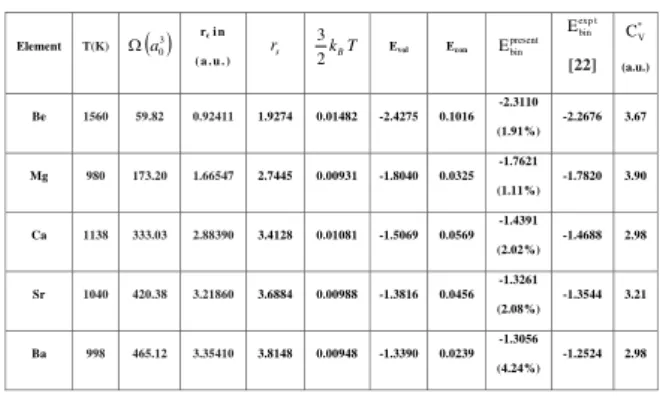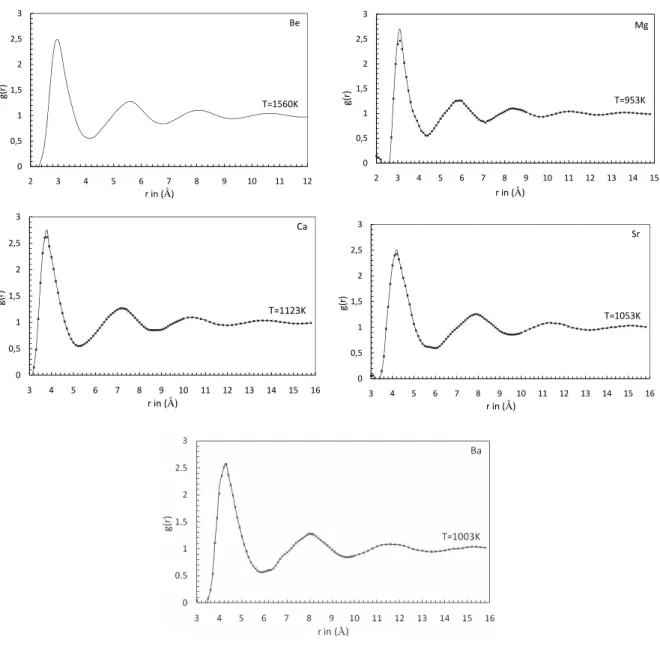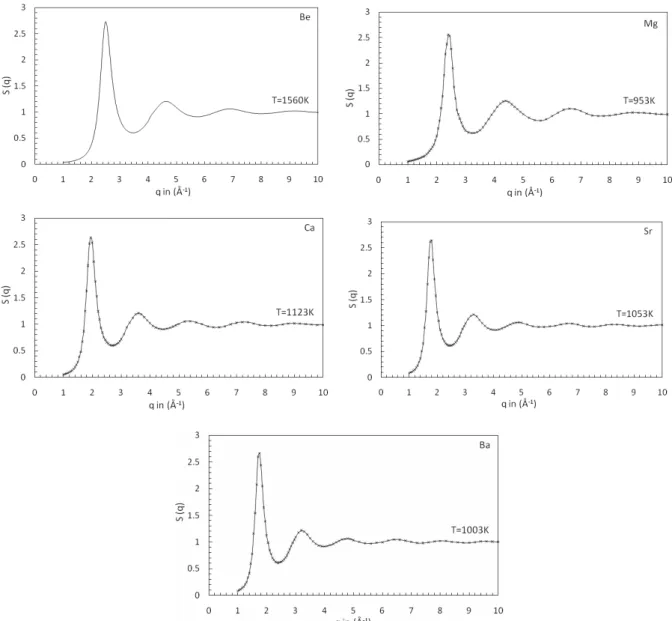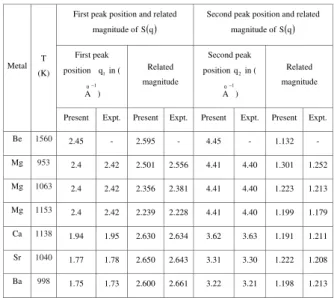Structural Studies of Liquid Alkaline-earth Metals -A Molecular Dynamics Approach
J. K. Baria
V. P. & R. P. T. P. Science College, Vallabh Vidyanagar – 388 120, Gujarat, India
A. R. Janib
Department of Physics, Sardar Patel University, Vallabh Vidyanagar – 388 120, Gujarat, India.
(Received on 14 January, 2010)
In the present research article we have studied various properties like binding energy, the pair distribution functiong(r), the structure factorS(q), specific heat at constant volume, and coordination number of alkaline-earth metals (Be, Mg, Ca, Sr, and Ba) near melting point temperature using molecular dynamics (MD) simu-lation technique with a pseudopotential proposed by us. Good agreement with the experiment is achieved for the binding energy, pair distribution function, and structure factor and these results compare favorably with the results obtained by other such calculations, showing the transferability of the pseudopotential used from solid to liquid environment in the case of alkaline-earth metals.
Keywords: Molecular dynamics; Pair distribution function; Structure factor; Binding energy
1. INTRODUCTION
The alkaline-earth metals (IIA column) can be considered as simple metals in regard of the electronic aspect, they are certainly the less studied elements among the metals. From the experimental point of view, only a few properties have been determined to date. Indeed, we can mention the elec-trical resistivity [1], the absolute thermopower [2], the static structure [3], the sound velocity [4], and the density [5]. This is due to the high chemical reactivity and to the gas adsorp-tion ability [6] that further increase with temperature. These difficulties have induced a low interest for technological pur-poses and a disinterest for theoretical work on alkaline-earth metals, while alkali and polyvalent ones were often preferred. However, alkaline-earth metals have a central place. On one hand, they can be considered as simple and free-electron-like, since they have only s-like conduction electrons. Beryllium and magnesium, essentially free-electron-like, are as simple as sodium [7]. On the other hand, in the case of Ca, Sr, and Ba the existence of an emptyd-band above the Fermi level, which get nearer as one goes down the (IIA column) [8] has a great influence on the electronic properties. This explains the high electrical resistivity of liquid barium [1,9].
Table 1. Input parameters used in the calculation and the binding Energy (in Ryd.) and specific heat at constant volume. The value in the ( ) parentheses shows the percentage deviation of
the binding energy from the experimental findings.
Element T(K) Ω( )a30
rc i n
( a . u . ) s
r kBT
2 3
Evol Econ Epresentbin t exp bin
E
[22] * V
C (a.u.)
Be 1560 59.82 0.92411 1.9274 0.01482 -2.4275 0.1016 -2.3110
(1.91%)
-2.2676 3.67
Mg 980 173.20 1.66547 2.7445 0.00931 -1.8040 0.0325 -1.7621
(1.11%)
-1.7820 3.90
Ca 1138 333.03 2.88390 3.4128 0.01081 -1.5069 0.0569 -1.4391 (2.02%)
-1.4688 2.98
Sr 1040 420.38 3.21860 3.6884 0.00988 -1.3816 0.0456 -1.3261
(2.08%)
-1.3544 3.21
Ba 998 465.12 3.35410 3.8148 0.00948 -1.3390 0.0239 -1.3056 (4.24%)
-1.2524 2.98
Recent works [8,10–12] have been devoted to this class of elements to see trends through the Periodic Table and to study
the transition from alkali to more complex metals in relation to the influence of the electron gas. Alemany et al. [12] also computed the velocity auto-correlation function VACF, its memory function and the self-diffusion coefficient.
In this paper, we study the properties like binding energy, the pair distribution function g(r), the structure factor S(q), specific heat at constant volume, and coordination number using molecular dynamics (MD) simulation technique with a pseudopotential of Baria and Jani [13-15] for alkaline earth metals, namely beryllium, magnesium, calcium, strontium, and barium. We present the results of the static properties i.e., Binding energy, the structure factor, and the pair distribution function and compared with both experimental and theoreti-cal previous works, as well as the VACF and its spectral den-sity. Because of the lack of experimental data for VACF and its spectral density, we are only able to compare our results with the recent ones of Alemanyet al.[12]. Our calculations have been performed with the molecular dynamics simulation technique with the pseudopotential of Baria and Jani [13-15] in the second-order perturbation theory.
2. THEORY
Simple metals are usually depicted as an assembly of ions of well-defined electric charge immersed in the bath of the conduction electrons, the global system being electrically neutral. Since the number of conduction electrons per atom has an integer value (Z=2 for alkaline-earth metals), the direct ion-ion repulsion, essentially Coulombic, is easy to describe contrary to the transition metals. In contrast, the description of the effective ion-ion interaction is drastically affected by the electron-electron and the electron-ion interactions.
The electron-electron interaction relies on the electronic charge density, which takes also a well-defined value for sim-ple metals. Its description is performed in terms of screening with two functions, the Lindhard-Hartree dielectric function εH(q)and the local-field correctionG(q), which account for
effect is now a days well-predicted by Monte Carlo tech-niques, and the Ichimaru and Utsumi [17] IU expression of the local-field correction used in this work is certainly one of the most reliable. Since alkaline-earth metals are simple like metals, the main difficulty in the calculation of the effective ion-ion interaction lies in the description of the electron-ion interaction. Thus, the effective pair potential can be obtained from the perturbation theory applied to second order to the determination of the configurational energy of the material,
u(r) =Z 2
r − 2Z2
π
Z ∞
0
FN(q)
sin(q r)
q r dq (1)
FN(q)being the normalized energy-wave number
character-istic,
FN(q) =
q2V 4πZ N
2
1− 1 ε(q)
1 1−G(q)
|WB(q)|2
(2) Where,VN =Ω0, being the atomic volume, the electron-gas
di-electric functionε(q), and the local-?eld correctionG(q) that takes into account the exchange-correlation effects [17] be-tween conduction electrons andWB(q)is the pseudopotential
proposed by Baria and Jani [13-15], (in Ryd. Unit) is given by,
WB(q) =−
8πZ Ω0q2
4(cos(q rc)−1) q2r2
c +
4 sin(q rc)
q rc +
sin(q rc)
(1+q2r2 c)3
5 q rc−4 q3r3c−q5r5c
+ cos(q rc)
(1+q2r2 c)3
11q2r2c+4 q4r4c+q6r6c
+2 e q2r2c(q2r2c−3)
(1+q2r2 c)3
−cos(q rc)
(3)
whererc is the parameter of the potential and e the base of
natural logarithm. We have calculated the parameter of the potential rc using standard zero pressure technique. The cor-responding parameters are compiled in Table I. One further variable aspect of the pseudopotential formalism is the choice of the exchange-correlation function, G(q). We employ the expression exempt from free parameters developed by Ichi-maru and Utsumi [17].
In the framework of the second-order perturbation theory of the pseudopotential, the binding energy is given by the en-ergy of an atom as,
Ebin=
3
2kBT+Econ+Evol (4) The configurational energy Econ is obtainable directly by
molecular dynamics or from its definition in terms of pair dis-tribution functiong(r),
Econ=
N 2V
Z
u(r)g(r)dr (5) The volume-dependent contribution to the binding energy, Evol, is given according to the prescription of Hasegawa and
Watabe [18] by
Evol=Eeg− qlim→0
2πZ2N V
π 4kF
−G(q) q2
− 1 2Vq
∑
6=04πZ2
q2 FN(q) =Eeg+Beg+Φ (6)
In this expression,Eegrepresents the ground state energy of
the electron gas, for which the following Nozieres-Pines [19] interpolation formula is used (within atomic units):
Eeg=
Z 2
2.21 r2
s
−0.916 rs
+0.031 ln(rs)−0.115
(7)
rs being the radius of the electronic sphere defined byr3s = 9π
4kF3 = 3 4π N ZV
. The first term of Eq. (7) is the kinetic en-ergy of the free electron gas, the second term is the attractive exchange energy due to the parallel-spin electrons separated by Pauli’s exclusion principle, and the third term is the cor-relation energy that gives an additional lowering in energy. In the right-hand side of Eq. (6), the second term, usually noted Beg, corresponds to a rearrangement of various ener-getic contributions for the zero-wave vector and the third term noted asΦ, represents the self-energy between an ion and its surrounding cloud of charge. In this context, the local pseu-dopotential assumed for the ion-electron interaction and the local-field correction G(q) considered for the exchange and correlation effects within the electron gas are crucial for ob-taining the volume-dependent energy.
3. MOLECULAR DYNAMICS SIMULATION
The molecular dynamics (MD) simulations are performed in the NVE microcanonical ensemble. The system is a cubic box containingN atoms with periodic boundary conditions and the box sizes are fitted to the desired density, ρ=N
V =
1
Ω0. During the thermalization stage, the system relaxes and
the velocities are rescaled each 50 time steps to the expected temperature. Once the system is thermalized, the production stage is launched and positions and velocities of the particles are taped each 5 (for dynamical properties) or 10 (for static ones) time steps. During this stage, the temperature is no more renormalized. Because of the statistical fluctuations, for which standard deviations of the temperature are a few tenths of degrees, the effective temperature during the production differs from the expected one.
0 0,5 1 1,5 2 2,5 3
g(
r)
2 3 4 5 6 7
r in (Å)
8 9 10 11
T=1560 B
12 K Be
0
0,5 1 1,5 2 2,5 3
2 3 4 5 6 7 8 9 10 11 12 13 14 15
Mg
g(r)
r in (Å)
T=953K
0 0,5 1 1,5 2 2,5 3
g(
r)
3 4 5 6 7 8 9 10
r in (Å)
11 12 113 14 15 T=1123 C
16 K Ca
0 0,5 1 1,5 2 2,5 3
g(
r)
3 4 5 6 7 8 9 10
r in (Å)
11 12 113 14 15 T=1053 S
16 K Sr
FIG. 1: Pair distribution functiong(r) for Be, Mg, Ca, Sr and Ba near melting temperature. Full lines are our molecular-dynamics results. Cross (x) are the experimental results of Waseda [20].
be seen later, the self-diffusion coefficient is highly sensitive to the temperature. It is worth to mention that the isother-mal MD simulation, which requires the renorisother-malization of the velocities, is prescribed in observing the evolution of a tagged particle in order to compute the VACF. Depending on the physical properties under study, two different sizes for the simulation box is used; 256 particles for dynamical proper-ties and 2048 particles for static properproper-ties. The bigger is the system, the faster is the thermalization and the smaller are the fluctuations of the temperature. Knowing a great number of successive configurations, the pair distribution function g(r) can be determined from the relationship,
g(r) = n(r) 4
3π ρC
h
(r+δr)3−r3i (8)
Where,Cis the number of configurations taped and n(r) is the number of atoms counted at a distance betweenrandr+δr
from another atom taken as origin. As we said, for computing the static structure the box containsN=2048 atoms in order to ensure a large enoughrextension of g(r). So, the structure factor S(q) is obtained straightforwardly by Fourier transform as,
S(q) =1+ρ
Z
[g(r)−1]exp(−q·r)·dr (9)
Another function 4π ρr2g(r)obtained fromg(r)is used in the discussion of the structure of non-crystalline systems. This has been called the radial distribution function (RDF). This function corresponds to the number of atoms in the spherical shell betweenrandr+dr, the coordination number, and is obtained from relation [20],
n1=
Z rm
r0
4π ρr2g(r)dr (10) Where,r0is the left hand edge of the first peak andrm
FIG. 2: Structure factor S(q) for Be, Mg, Ca, Sr and Ba near melting temperature. Full lines are our molecular-dynamics results. Cross (x) are the experimental results of Waseda [20]. Structure factor S(q) for Be, Mg, Ca, Sr and Ba near melting temperature. Full lines are our molecular-dynamics results. Cross (x) are the experimental results of Waseda [20].
peak in RDF.
4. RESULTS AND DISCUSSION
To determine the binding energy by Eq. (7), we first calcu-late the configurational internal energyEconby MD
simula-tion. We also take advantage of the fluctuations in this energy during the course of the calculation to evaluate the specific heat at constant volume using the standard expression [21],
CV∗= CV
N kB
=3
2
1−
3ND(δEcon)2 E
2hEkini2
−1
(11)
hEkinibeing the average kinetic energy andδEcon, the
fluctu-ation in the configurfluctu-ational energy, Table 1 presents potential
parameter rc,CV∗ andEconwith the other contribution to the
volume-dependent energy, as well as the experimental bind-ing energy [22]. Note that the main contributionΦ, to the binding energy comes from the electrostatic interaction be-tween an ion and its own screening cloud of electrons. Our present values of binding energies are in good agreement with the experimental values within percentage deviation of 1.11% to 4.24%.
As a test of transferability of the pseudopotential under study, we can compare the binding energy with experiment since it corresponds to the sum of the ionization energies of the valence electrons,Eion, and the cohesive energy,Ecoh.
In-deed, we recall that the conventional binding energy can be written [23] as
E=−(Eion+Ecoh) (12)
pre-Table 2. First and Second-Peak position ofg(r), and their related magnitude with the Coordination number.
( )
Metal T
(K)
First peak position and related
magnitude of g( )r
Second peak position and related
magnitude of g( )r
Coordination
number n1
First peak
position r1 in ( 0
A)
Related magnitude
Second peak
position r2 in ( 0
A)
Related magnitude
Present Expt.
Present Expt. Present Expt. Present Expt. Present Expt.
Be 1560 3.0 - 2.484 - 5.6 - 1.277 - 10.1 -
Mg 953 3.1 3.21 2.701 2.294 6.1 6.0 1.240 1.252 11.2 10.9
Mg 1063 3.1 3.21 2.503 2.144 6.1 6.0 1.203 1.228 11.1 -
Mg 1153 3.1 3.21 2.411 2.126 6.1 6.0 1.186 1.208 11.0 -
Ca 1138 3.8 3.83 2.751 2.614 7.4 7.3 1.264 1.243 11.2 11.1
Sr 1040 4.2 4.23 2.510 2.421 7.9 8.0 1.240 1.248 11.2 11.1
Ba 998 4.3 4.31 2.582 2.561 8.2 8.1 1.260 1.276 10.9 10.8
sented in Fig. 1 for Be, Mg, Ca, Sr, and Ba near their melting point temperature in comparison to the experiments [20]. To the best of our knowledge, no experimental results have ever been published for Be. For Mg, Ca, Sr, and Ba there is a slight overestimation of the height of the first peak with the experimental values of Waseda [20] except these, our present findings are excellent. The corresponding static structure fac-torsS(q) are displayed in Fig. 2. Though our calculations are performed with 2048 particles, we can see that the low-q be-havior ofS(q) is poorly described because of the smallness of the simulation box. The mesh in theqspace being governed by the extension ofg(r), it may happen that the curves ofS(q) are not smooth in some crucial ranges, like the position of the main peak, due to the lack of points. Thus, for Mg, Ca, and Ba, the height of the first peak ofS(q) seems to be slightly un-derestimated. Except these small differences, the agreement between our calculations and experiments [20] is overall very satisfactory. The first and second peak position and its rela-tive magnitude ofg(r), and coordination number are shown in table 2 while first and second peak position and its relative magnitude ofS(q) are shown in table 3. Presently calculated values of first and second peak position ofg(r), coordination number andS(q) are excellently agrees with the experimental findings of Waseda [20] for Mg, Ca, Sr and Ba while for Be, no experimental data are available for comparison.
5. CONCLUSION
It is rather difficult to estimate the error for the dynamical properties in computer simulations because many factors in-fluence the results of the calculations. These are the relatively small number of particles, the periodic boundary conditions, the number of configurations used in calculating various av-erages and the shortcomings of the pair potential, and hence the pseudopotential.
The properties of crystalline and liquid phases are found to be adequately modeled by the pseudopotential of Baria and Jani [13-15]. Since the self-diffusion coefficient is very sensi-tive to the temperature and it is doubled at least at each 400K, it might be a very accurate test of the potential. The static
TABLE 3. First and Second-Peak position ofS(q), and their related magnitude.( )
Metal T
(K)
First peak position and related magnitude of S( )q
Second peak position and related magnitude of S( )q
First peak position q1 in (
1 0
A −
)
Related magnitude
Second peak position q2 in (
1 0
A −
)
Related magnitude
Present Expt. Present Expt. Present Expt. Present Expt. Be 1560 2.45 - 2.595 - 4.45 - 1.132 -
Mg 953 2.4 2.42 2.501 2.556 4.41 4.40 1.301 1.252
Mg 1063 2.4 2.42 2.356 2.381 4.41 4.40 1.223 1.213
Mg 1153 2.4 2.42 2.239 2.228 4.41 4.40 1.199 1.179 Ca 1138 1.94 1.95 2.630 2.634 3.62 3.63 1.191 1.211 Sr 1040 1.77 1.78 2.650 2.643 3.31 3.30 1.222 1.208
Ba 998 1.75 1.73 2.600 2.661 3.22 3.21 1.198 1.213
structure does not appear to be very sensitive to it as we can see from the results of g(r) and S(q), both being in very good agreement with experiment. So, for this kind of metals, we have to consider a much more sensitive property, and the self-diffusion coefficient could be this one. Unfortunately, the lack of experimental value prevents definitive conclusions.
To conclude, we have performed molecular dynamics study of liquid alkaline-earth metals with pseudopotential of Baria and Jani [13-15] in order to check the transferability of the model. Considering that this pseudopotential is exempt from adjustable parameters, the good quality of our results of the structure factor is a strong argument in favor of the trans-ferability of the pseudopotential from the solid state to the liquid state for alkaline-earth metals as far as the pair poten-tial and the ionic structure is concerned. The study of the dynamic properties and above the entire self-diffusion coef-ficient points out the relevance of this latter quantity to deal with the transferability of the pseudopotential. The existence of experimental data would be helpful.
Acknowledgement
[1] J.B. van Zytveld, J.E. Enderby, and E.W. Collings, J. Phys. F: Met. Phys.273 (1972).
[2] J.B. van Zytveld, J.E. Enderby, and E.W. Collings, J. Phys. F: Met. Phys.31819 (1973).
[3] Y. Waseda, K. Yokoyama, and K. Suzuki, Philos. Mag.301195 (1974).
[4] S.P. McAlister, E.D. Crozier, and J.F. Cochran, Can. J. Phys. 521847 (1974).
[5] S. Hiemstra, D. Prins, G. Gabrielse, and J.B. van Zytveld, Phys. Chem. Liq.6 271 (1977).
[6] J.G. Cook and M.J. Laubitz, Can. J. Phys.54928 (1976). [7] G.A. de Wijs, G. Pastore, A. Selloni, and W. van der Lugt,
Phys. Rev. Lett.754480 (1995).
[8] W. Jank and J. Hafner, Phys. Rev. B426926 (1990).
[9] V.K. Ratti and R. Evans, J. Phys. F: Met. Phys.3L238 (1973). [10] L.E. Gonzalez, A. Meyer, M.P. Iniguez, D.J. Gonzalez, and M.
Silbert, Phys. Rev. E474120 (1993).
[11] Hong Seok Kang, Phys. Rev. B606362 (1999).
[12] M.M.G. Alemany, J. Casas, C. Rey, L.E. Gonzalez, and L.J. Cal-lego, Phys. Rev. E566818 (1997).
[13] J. K. Baria, A. R. Jani, Physica B328317 (2003). [14] J. K. Baria, A. R. Jani, Pramana J. Phys.601235 (2003). [15] J. K. Baria, A. R. Jani, Physica B4042401 (2009).
[16] J.-F. Wax and J.-L. Bretonnet, J. Non-Cryst. Solids250-25230 (1999).
[17] S. Ichimaru and K. Utsumi, Phys. Rev. B247385 (1981). [18] M. Hasegawa and M. Watabe, J. Phys. Soc. Jpn.32 14 (1972). [19] D. Pines and P. Nozie‘res,Quantum Liquids Benjamin, (New
York, 1966).
[20] Y. Waseda, The Structure of Non Crystalline Materials
(McGraw-Hill, New York, (1980).
[21] J.M. Haile, Molecular Dynamics Simulation: Elementary Methods(Wiley, New York, 1992).



